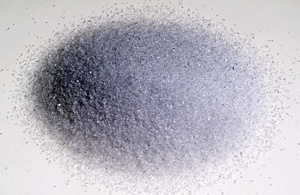Aluminium oxide is one of the preferred blast agents for tool steel and glass
Corundum is available in various quality grades - and aluminium oxide is one of them
The word corundum comes from the Sanskrit word for the mineral, “kurivindalt”. Natural deposits of corundum are found mainly in Burma, India, Sri Lanka and Tanzania. But it is also found in Germany, especially in the Black Forest, the Bavarian Forest and in the Upper Palatine Forest. Corundum is the second-hardest mineral after diamond. For industrial purposes, corundum and in particular aluminium oxide are produced synthetically nowadays. “White aluminium oxide” is primarily manufactured, with the raw material for this being high-purity aluminium oxide. With the addition of other materials, pink aluminium oxide and ruby corundum can also be produced. A distinction is made between the following types of corundum, based on their composition and chemical properties:
- Regular corundum with iron content: cleaning blasting, mattifying of surfaces
- Semi-friable aluminium oxide: blasting of high-rigidity steel that is impervious to heat
- White aluminium oxide without iron content: blasting of tool steel and glass
- Pink aluminium oxide: high edge strength, used like white aluminium oxide
- Ruby corundum: blasting of steels with high alloy contents
Blast agents are available in various grain sizes, classified using sieves. Essentially, blast agents and aluminium oxide can be classified based on the following guideline parameters:
- Hardness: The harder the blast agent, the more powerful its effect. This applies both to the speed with which the effect takes place and to the degree of keying. The usual units for comparing hardness are the Mohs scale or the Rockwell scale. According to the Mohs scale, aluminium oxide has a hardness of 9, with diamond having 10. By way of comparison, talcum powder has a hardness of 1.
- Blast grain size: the larger the blast grain, the greater its force when it impacts on the workpiece. An even blast result is only achieved if the blast grains are all the same size. The coarser the blast agent, the rougher the surface. The finer the grain, the more intensive the blasting. Aluminium oxide is available in various sizes.
- Shape of the blast grain: round blast grains achieve the effect on the surface primarily through impact energy, while sharp-edged particles rub and cut at the surface.
- Origin of the blast agent: a distinction is made between natural blast media and industrially manufactured media. Natural media include by-products from the agricultural industry, such as nut shells, ground fruit kernels, milled chaff or even rice husks. Industrially manufactured blast agents are formed from by-products of slag from ore refineries, including non-metallic components such as aluminium oxide or glass, or metallic blast agents made from aluminium, bronze or brass. Aluminium oxide is primarily produced industrially these days.
Do you need advice on the right blast agent, or would you like to order aluminium oxide for your blast systems? Then get in touch – either by phone on +49 (0) 7741 808 93 0 or by e-mail to info(at)sigg-strahltechnik(dot)de



![[Translate to Englisch:] SIGG Strahltechnik [Translate to Englisch:] SIGG Strahltechnik](/fileadmin/user_upload/slider/slider_fullsize/Strahlmittel/SIGG-Strahltechnik-Oberflaechen-Autor.jpg)

